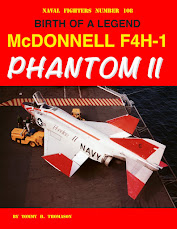From a detailed and illustrated Britmodeller review HERE
Tony Buttler, a well-known and prolific author, has written an excellent, well-illustrated monograph on the less-appreciated McDonnell F3H Demon. It is a very complete history in 48 pages plus softcover. There are lots of photographs, many in color, of the XF3H-1 prototypes, the J40-powered F3H-1N, and the J71-powered F3H-2 variants. Several pages of color profiles are provided as well as well as a large multi-view drawing at the centerfold. The paper quality is more than adequate for good reproduction of all the illustrations. See the link above for details.
Since this book deserves to be the cornerstone print reference, if not the only one, for the F3H in some libraries, I feel obligated to correct a few misstatements. First, the F3H wing did not have anhedral (page 22); see http://tailspintopics.blogspot.com/2014/03/anhedraldihedral-and-wing-sweep.html. I'm all but certain that the first Sparrow missile firings by a deployed squadron were accomplished by a VX-4 detachment of F7U-3Ms on Shangri-La in early 1957, not VF-64 F3Hs in December 1958 (page 35). A really minor correction is that the drawing of the F3H-2M is shown with the short beaver tail in the centerfold; all were built with the longer one and I doubt that any were retrofitted.
I'm pretty sure that the lineup of F3Hs on page 17 are four of the six involved in the Fleet Introduction Program described in the text with side numbers 10 through 15. Note that these, as well as some other early production Demons, have small, blue, government-furnished AERO pylons on the wings as the changeover to gray/white exterior paint had just occurred.
An oddity not mentioned or illustrated was one of the attempts at providing self-boarding (no separate ladder) on these big jets that set so nose high. See http://thanlont.blogspot.com/2009/06/self-boarding.html and http://thanlont.blogspot.com/2008/05/i-had-hoped-to-find-picture-like-this.html
No photos or illustrations of the cockpit are provided. For the F3H-1N cockpit layout, see http://tailhooktopics.blogspot.com/2014/06/converting-f3h-2-to-f3h-1n.html. For very complete coverage of a restored cockpit on the F3H at the National Museum of Naval Aviation, see Don Hinton's photographs here: http://www.philsaeronauticalstuff.com/f3h/f3h.html. (I suspect that the instrument panel was really dark gull gray with black instruments before the restoration; see https://www.flickr.com/photos/landon-smyth/7866045982/ for a picture of the cockpit of a different F3H, Intrepid's, during a restoration.)
For details on the Sparrow I (F3H-2M) and Sparrow III (F3H-2), see http://tailspintopics.blogspot.com/2013/08/things-under-wings-sparrow-missiles.html
Minor omissions and errors like these do not materially detract from the value of this book to the naval aviation enthusiast. I am very pleased to have been provided a copy by Tony.








